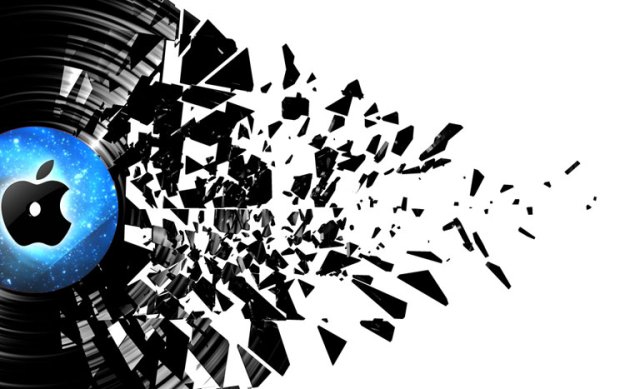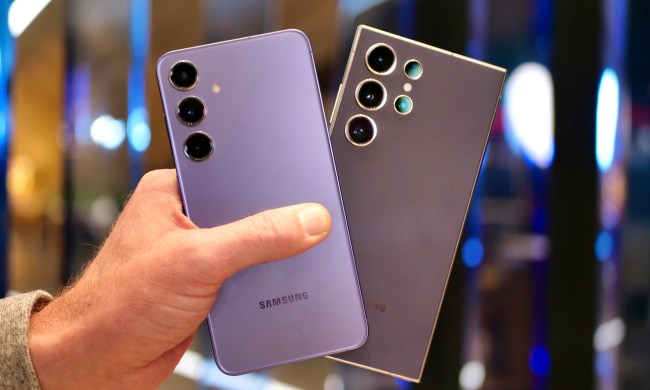
The digital music revolution has left a lot of roadkill on the side of the information superhighway. For every seeming digital success story like Lady Gaga offering an album for $0.99, thousands of artists — signed and unsigned — have seen virtually no benefit from digital music. Sure, it’s easier than ever to make material available, even if you don’t have a deal with a record label, but that doesn’t mean being a music artist is any easier today than it was back before iTunes came along.
Speaking at the inaugural John Peel lecture at the 2011 Radio Festival in Salford, Pete Townsend called on Apple to do more to support musicians and support their career development in ways that used to be performed by record labels and publishers.
“Is there really any good reason why, just because iTunes exists in the wild west Internet land of Facebook and Twitter, it can’t provide some aspect of these services to the artists whose work it bleeds like a digital vampire [..] for its enormous commission?” Townsend asked.
Townsend outlined several suggestions for ways Apple could help support artists, including having Apple select 500 artists the company felt were particularly worthy of attention and supporting them with free computers as well as assistance with marketing, copyright, and distribution, perhaps with the assistance of 20-or-so talent scouts from “the dying record business.” Townsend also suggested iTunes should enable artists to share their music “like a local radio station.”
The good old days
The crux of Townsend’s argument is that when you hear a three-minute song via the Internet, you’re not just hearing something an artist tossed off in three minutes. Simply recording and producing that track probably took hundreds of hours and (at least) thousands of dollars in studio, engineering, and mastering fees. And let’s not count the years artists put into learning and honing their crafts. Record labels used to help with that: Labels would seek out raw, undiscovered talent and — in exchange for a percentage of future earnings — foster artists’ development. That could mean setting them up with music directors, engineers, producers, studio time, and A&R people; heck, sometimes it meant setting them up with a place to live and groceries. Assistance could also mean vocal coaches, songwriting partners, and what Townshend called “creative nurture” — enabling artists to continue with their own development without having to worry about whether the lights were going to stay on. When an artist got closer to market, the label would also help out with marketing and copyright, as well as the raw work of distribution and setting up tours.
To be sure, many record deals were nasty pieces of work that would only have been signed by naïve and drug-addled dreamers. Many artists never got out of “label debt” from their deals and walked away (or were kicked to the curb) with little more than the shirts on their backs. But the point — Townsend’s point, at least — is that the labels at least tried to develop artists and an industry. In contrast, service like iTunes handle two things and only two things: distribution to a single channel, and royalty payments.
iTunes’ money
Townsend’s focus on iTunes is understandable: Apple’s iTunes Music Store controls about three quarters of the market for legal digital music purchases worldwide. iTunes music sales are still growing, boosted by a general uptick in music sales so far in 2011 — fueled perhaps by the shutdown of Limewire and and the addition of the Beatles — which iTunes picked up exclusively almost a year ago. The average price of music tracks is higher than ever, labels are bundling together enhanced versions of albums at premium pricing, and 2011 is starting to look like a year when the U.S. music business, at least, will see an increase in sales.
How big is iTunes’ business? Apple doesn’t break out music sales specifically in its financials, but digital music sales were about $5.2 billion in the United States alone during 2010; 2011 looks to be on track for about $5.7 billion. iTunes controls about three quarters of the digital music market, so in the U.S. alone let’s say iTunes handles about $4 billion in digital music sales, of which it takes a 30 percent cut, meaning Apple pockets over $1 billion a year from U.S. digital music sales alone. That puts Apple’s U.S. digital music revenues in the same league as the Big Four music labels (Warner, Universal, Sony, and EMI, although EMI is probably going away).
How does that work out for artists?
Townsend’s argument is that Apple’s iTunes music business is essentially leeching off the efforts of artists, taking an “enormous” commission and investing none of that money back into artist development. He has a point: Talk to anyone in the music business and they’ll tell you record labels long since stopped looking for acts they can develop and craft into money-makers. They’re looking for already-honed and packaged performers, preferably with an album already produced and paid-for out of their own pockets. They can simply sign and drop it into distribution and marketing channels with as little labor as possible. Most artist development now comes at the artists’ own expense, while record labels and iTunes continue to pull in real money.
It’s tempting to claim that services like iTunes, Spotify, and Pandora make things easier for artists by removing “middle men” like record labels and enabling artists to reach out to fans and customers directly. And, to an extent, that is true: musicians no longer need to be signed to a record label to make their material available via iTunes.
Although the exact percentages of artists’ deals vary, depending how they choose to get their music into digital music services, whether they have a distribution deal, etc., the basic breakdown is as follows:
| $0.99 Single | $9.99 Album | |
|---|---|---|
| iTunes | $0.69 | $6.90 |
| Amazon MP3 | $0.69 | $6.90 |
| eMusic | $0.30 | $2.60 |
| Spotify | $0.004 per play | $0.04 per full album play |
| Pandora | (royalty determined by performing rights agencies) | |
To the best of our knowledge, these represent best-case figures.
Don’t spend it all in one place
Amazon’s and iTunes’ numbers are a 70/30 split with artists. In reality, most artists don’t see the full 70 percent of sales revenue, because even independent artists almost always have to go through a distributor to get their music into iTunes. Those distributors charge a flat fee (like CD Baby‘s $9.95 per single or $39 per album) or a percent of digital sales, sometimes both.
Nonetheless, those 70/30 splits represent the best deal out there. With Spotify, an artist needs listeners to stream 1,000 songs (or their album 100 times) to earn about $4. Users can, of course, stream music from Spotify for free, but there’s no indication that subscribing to Spotify in any way increases the revenue artists see from allowing their music to be streamed. This probably accounts for why a number of independent labels have left Spotify.
Pandora pays licensing fees to performing arts agencies like ASCAP, BMI, SESAC, and SoundExchange for the music it streams; those agences are, in turn, responsible for distributing royalties to artists. While these agencies collect millions of dollars every year and funnel a great deal of that money back to record labels and publishers, it’s extremely rare for independent artists to realize any significant royalties through these agencies, let alone royalties from streaming.
As an example, I’ve been registered with leading performing arts agencies for over two decades; music for which I am eligible for royalties has been regularly distributed via film, television, radio, the Internet — heck, I’ve even heard it in Starbucks and via Pandora. The amount of income I have received from these agencies in my entire career to date wouldn’t pay for an iPod.
Payments to artists who have deals with record labels also vary widely. If an artist receives (say) a $20,000 advance to finish production on a debut album, the label will take that $20,000 (plus interest) off the top of any revenues generated by the artists. Many artists never earn back this so-called “label debt,” and $20,000 is a pretty low figure. The marketing budget alone to push a pop single is routinely in the million-dollar range. Artists who don’t earn back their label debt often wind up surrendering future royalties or publishing rights to the label in perpetuity to get out from under the deal. The process is the same as the old-school record contracts that famously left performers and songwriters without any rights to their recordings and material.
This discussion also omits publishing revenues. If an artist covers a song written by someone else, in theory the original songwriter(s) will also receive a portion of the revenue so long as that material is still protected by copyright. This is usually handled by rights agencies.
Should artists be fostered?
Success in the music world is a complicated topic, and involves much more than rates paid for digital singles, albums, and streaming.
However old-school Pete Townsend’s thinking might be about artists needing recording companies or firms like Apple to serve as patrons to foster their talents and enable their creativity, he does have a point. For all the democratizing power of the Internet, the odds of a musician being able to earn a living from music sales are probably equivalent to going from playing high school basketball to being drafted by the NBA. For most artists, it’s just not going to happen, and the advent of digital music hasn’t changed the equation very much.
However, the explosion of digital music has shifted the economics of the music industry. Some of the money has disappeared, and some of it has gone to Apple and its ilk. After years of declining sales of physical albums (digital sales have yet to really make up the difference) record companies no longer seek out and develop talent. Instead, they’re mainly on the hunt for ready-to-go, highly-marketable acts that have already bootstrapped themselves into the industry. They aren’t going to take a chance on a quirky act that could become extraordinary, artists won’t get an album or two to find their legs and develop a voice. Either they’re ready to go from day one, or they’re out in the wind.
But here’s the thing: it’s called the music business, not music philanthropy. Almost everyone in the industry is in it to make money. That includes everyone from instrument makers to engineers to producers to record companies to tour managers to publishers to distributors like Apple. Sure, they all enjoy music and most believe in music, but none of them are doing it for free.
Except the artists. Townsend said it himself: “A creative person would prefer their music to be stolen and enjoyed than ignored. This is the dilemma for every creative soul: he or she would prefer to starve and be heard than to eat well and be ignored.”
Ultimately that means all those artists who don’t make the cut are going to be exploited by all those other people in it to make money. Same as it ever was.
[Image courtesy of GrandeDuc/Shutterstock]


